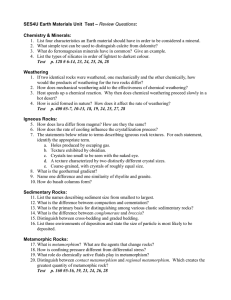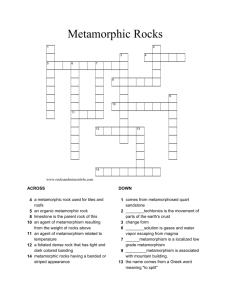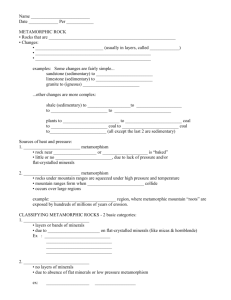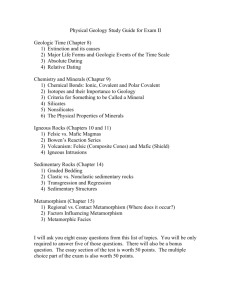PPT - Huntingdon College
advertisement
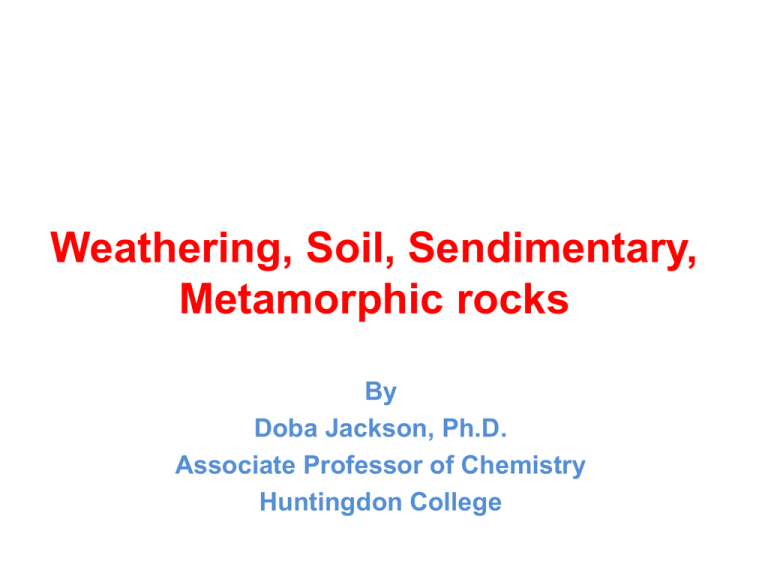
Weathering, Soil, Sendimentary, Metamorphic rocks By Doba Jackson, Ph.D. Associate Professor of Chemistry Huntingdon College Mechanical and Chemical Weathering • Rocks and minerals are disintegrated and decomposed by the processes of mechanical and chemical weathering. – The products of weathering include soluble salts, ions in solution, and solid particles which can be eroded and become sedimentary rock or modified in place to become soils. Weathering and Erosion • How does weathering differ from erosion? – Weathering is the mechanical and chemical alteration of Earth materials at or near the surface – Erosion involves removing weathered materials from their place of origin-by running water or wind, for example. Mechanical Weathering – Disaggregation of Earth Materials • Mechanical weathering includes the processes of – Frost action – Pressure release – Thermal expansion and contraction – Crystal growth – Activities of organisms. Products of Mechanical weathering is chemically the same as it was prior to the weathering. Mechanical Weathering – Freeze-Thawing - When water freezes in cracks in rocks it expands and then it contracts when it thaws, thus exerting pressure and opening the cracks wider. - Repeated freezing and thawing disaggregates rocks into angular pieces that may tumble downslope and accumulate as talus. Mechanical Weathering – Pressure Release Rock formed underground at higher pressure can undergo an expansion under lower pressure on the earth’s surface. – Sheet joints are fractures that more or less parallel exposed rock surfaces, especially rocks now at the surface that formed under great pressure at depth. Mechanical Weathering – Living Organisms, Plants, Trees, • How do organisms contribute to mechanical and chemical weathering? – Any plant or tree roots growing in cracks contributes to mechanical weathering by exposing the cracks inside the rocks and supplying water and other chemicals to them Chemical Weathering – Decomposition of Earth Materials • Chemical weathering processes include – Solution – Oxidation – Hydrolysis • Hot and wet environments accelerate chemical weathering. • Chemical weathering occurs in all environments, except, possibly, permanently frozen polar regions. Chemical Weathering – Dissolution or deposition in fluids Dissolution of Carbonate rocks (Limestone, Dolomite) • Solution/Dissolution – – rocks dissolve • Carbonate Rocks – Rocks such as limestone (CaCO3) are nearly insoluble in neutral or alkaline solutions, but they rapidly dissolve in acidic solutions Oxidation of Iron, Magnesium and other metals • Oxidation – – rocks rust – Rocks such as sandstone may contain iron minerals that will breakdown when exposed to the atmosphere Fe Iron in any rock + O2 Oxygen in the air Fe2O3 Iron Oxide (Rust) Oxidation of Iron, Magnesium and other metals • Oxidation – Iron Oxide (Fe2O3) can further break down in the presence of water to Iron Hydroxide Fe2O3 + H2O Iron Oxide Water Fe(OH)3 Iron Hydroxide Hydrolysis of Rock by water to form Clays • Hydrolysis – breakdown to clays – Potassium feldspar • During hydrolysis hydrogen ions react with and replace positive ions in potassium feldspar • The result is clay minerals and substances in solution such as potassium and silica. KAlSi3O8 Orthoclase + CO2 + H2O Al2Si2O5(OH)4 + Clay (Kaolinite) SiO2 + KHCO3 Silica How does mechanical weathering contribute to chemical weathering Sandstone Arches at Arches National Park, Utah Soil and Its Origin • Soils consist of weathered materials, air, water, humus and also the plants which they support. Soil and Its Horizons • Soil formation produces horizons that are known in descending order as O, A, B, and C. – These horizons differ from one another in texture, structure, composition and color. Soil and Its Horizons • Upper Layer (O) Humus – Consists of decayed organic matter necessary for plant life. The dark color comes from Humus. Soil and Its Horizons • Topsoil (A) – Less Humus but lots of microbes, insects, plant material. Also has lots of water, clays and quartz Soil and Its Horizons • Subsoil (B) – Little to no Humus. Mostly degraded minerals • Weathered Bedrock (C) – Weathered rock. Cannot grow and living organisms. What factors control soil formation? – Soil formation is controlled by • Climate • Parent material • Organic activity • Relief and slope • Time Soil and Climate conditions Introduction to Sedimentary Rocks • What is sediment? – The two primary types of sediment are Detrital and Chemical. – Detrital sediment consists of solid particles, products of mechanical weathering. – Chemical sediments consist of minerals precipitated from solution by inorganic processes and by the activities of organisms. Sediment Sources, Transport, and Deposition • Detrital sedimentary particles are classified according to grain (particle) sizes, in decreasing diameter: – Gravel (> 2mm) – Sand (1/16 to 2 mm) – Silt (1/256 to 1/16 mm) – Clay (less than 1/256 mm; as mud) • During transport, abrasion effects reduce particle sizes (rounding). What is a depositional Environment? • Depositional environments are areas of sediment deposition. Lithification: Converting Sediment into Sedimentary Rock Lithification of sediment into sedimentary rock occurs by compaction and cementation. Cementation of Sedimentary Rocks Cementation is a process that glues the sediments together. -Calcium Carbonate (CaCO3) -Iron Oxide (Fe2O3) - Iron Hydroxide (Fe(OH)3) - Silica Dioxide (SiO2) These materials are the products of chemical weathering of rocks!!! Conglomerate and Sedimentary Breccia • Conglomerate- a sedimentary rock consisting of an aggregate of gravel (> 2mm rocks) solidified together with rounded edges. • Sedimentary Breccia- same as a conglomerate excepts it has sharp edges. Sand and sandstone is the most common sedimentary rock • Why is quartz the most common mineral in sandstone? • Quartz is a common mineral in many source rocks, and in addition it is very stable chemically and quite durable mechanically. Chemical Sedimentary Rocks SeaShells • Protective exoskeleton of Crabs, Lobsters, worms, Sea Urchins, etc. Other Carbonate Rocks: Limestone & Dolostone • Limestone is Calcium Carbonate but usually in a mixture with other minerals. • Dolostone forms when magnesium replaces calcium in limestone. Halites and Gypsum are formed when water evaporates • Bedded rock salt (halite) and rock gypsum are chemical evaporite sediments formed by precipitation of minerals during the evaporation of water. Coal: Biochemical sedimentary rock • Coal is a biochemical sedimentary rock composed largely of altered land plant remains Sedimentary Facies • Sedimentary Facies- Bodies of sediment or sedimentary rocks which are recognizably different from adjacent sediment or sedimentary rocks and are deposited in a different depositional (sub) environment are known as sedimentary facies. Marine Transgression • A marine transgression occurs when sea level rises with respect to the land, resulting in offshore facies overlying nearshore facies. • A marine regression, caused when the land rises relative to sea level, results in nearshore facies overlying offshore facies. Marine Regression • A marine regression, caused when the land rises relative to sea level, results in nearshore facies overlying offshore facies. • Notice the different slant in the facies between a transgression and regression. Important Resources in Sediments and Sedimentary Rocks • What is oil shale? • Oil shale is a fine-grained sedimentary rock that contains kerogen from which liquid oil and combustible gases can be derived. • None is mined at present in the United States because oil and gas from conventional sources are cheaper. Oil shale and tar sands are increasingly important petroleum reserves. Metamorphic Rocks Introduction to Metamorphism • What is metamorphism? • The transformation of rocks, usually beneath Earth's surface, as the result of heat, pressure, and/or fluid activity, produces metamorphic rocks • Why is metamorphism worth studying? • Metamorphism is an important process that is closely related to plate tectonics, the growth of continents, and even climate change. • It is also responsible for producing a number of economically valuable materials. • Though largely hidden from view, metamorphism is part of the world around you. The world would be a much different and less interesting place without it. Equilibrium and the Causes of Metamorphism • Intrusive magmas or deep burial provide heat which causes metamorphism. • Pressure is produced by overlying rocks (lithostatic) or is differential pressure produced by various stresses. Equilibrium changes • Equilibrium: A system in which all competing forces are balanced. • Minerals are no longer stable (no longer “in equilibrium”) as conditions change. Minerals can react with one another to create more stable kinds of minerals (heterogeneous metamorphic reactions) or undergo rearrangements in their atoms to reduce the strain that builds up within them (crystal lattice reorientation and polymorphic transformation). The Main Types of Metamorphism • Principal types of metamorphism – »Contact »Dynamic »Regional metamorphism Contact Metamorphism • Contact metamorphism – Contact metamorphism is when a body of magma alters surrounding rock. This provides intense heat which drives changes within the rock. Contact metamorphism Increased (or Differential) Pressure Lithostatic pressure is a uniform field of pressure experienced by most rocks beneath Earth’s surface. Like the hydrostatic pressure experienced by divers underwater, the pressure acting on a rock embedded in the crust “feels” the same from all directions. The Main Types of Metamorphism • Dynamic metamorphism – Dynamic metamorphism is associated with faults and areas where lots of pressure builds up in the crust, but the temperature is not very great, such as in the accretionary wedges at convergent plate boundaries. The Main Types of Metamorphism – Shock metamorphism is a type of dynamic (pressure-dominated) metamorphism associated with meteorite impacts. The pressure is extremely high relative to other natural processes that operate on Earth. Regional Metamorphism – Regional metamorphism is the most common type of metamorphism. As the name implies, regional metamorphism has a broad range. Temperature and pressure both act as driving forces for metamorphic reactions in regional metamorphism. Classification of Metamorphic Rocks • Metamorphic rocks are classified principally according to texture. The texture is » Foliated - Foliated texture is produced by the preferred orientation of platy minerals. » Nonfoliated - Nonfoliated textures do not exhibit preferred orientation of minerals. Foliated Metamorphic Rocks • What is foliated texture, and what are some examples of foliated rocks? – Foliated texture is produced by the preferred orientation of platy minerals. – Amphibolite is another fairly common coarse grained foliated metamorphic rock. Schist and Gneiss Non-Foliated Metamorphic Rocks • What is a common nonfoliated metamorphic texture, and what are some examples of nonfoliated metamorphic rocks? – Nonfoliated textures do not exhibit preferred orientation of minerals. – Common nonfoliated metamorphic rocks are marble, quartzite, greenstone, and homfels. Metamorphic Zones • What are isograds and metamorphic zones? – Metamorphic rocks often can be arranged in metamorphic zones which reflect the pressure and temperature conditions of metamorphism Some Economic Uses of Metamorphic Materials Marble

